How to stop redirects to and from whobabsaim.com
Notification SpamAlso Known As: whobabsaim.com pop-up
Get free scan and check if your device is infected.
Remove it nowTo use full-featured product, you have to purchase a license for Combo Cleaner. Seven days free trial available. Combo Cleaner is owned and operated by RCS LT, the parent company of PCRisk.com.
What is whobabsaim[.]com?
whobabsaim[.]com is a rogue website designed to present visitors with dubious content and/or redirect them to other dubious and possibly dangerous pages. Visitors to whobabsaim[.]com rarely access it intentionally - most are redirected to it by intrusive advertisements or Potentially Unwanted Applications (PUAs) already infiltrated into the system.
There are thousands of dubious sites on the web and whobabsaim[.]com shares many similarities with cvazirouse.com, check-you-robot.site, esmo.pro, and countless others.
![whobabsaim[.]com pop-up redirects](/images/stories/screenshots202007/whobabsaim-com-ads-main.jpg)
The behavior of whobabsaim[.]com is determined by visitors' geolocations, which the web page learns by checking their IP (Internet Protocol) addresses. I.e., whether users are redirected elsewhere and/or are presented with dubious material depends on their geolocations.
Additionally, whobabsaim[.]com uses browser notifications. If these are enabled, the website starts running intrusive advertisement campaigns. The delivered ads redirect to various untrusted/rogue, sale-based/promotional, deceptive, compromised, scam and malicious sites.
Furthermore, once clicked, intrusive ads can execute scripts to infiltrate (i.e. download/install) software into systems. Prime examples of content proliferated in this fashion are PUAs. These unwanted applications can have other/additional capabilities, aside from force-opening suspect websites.
Adware-type apps deploy intrusive advertisements, which significantly diminish the browsing experience, as they overlay web page content and reduce browsing speed. Browser hijackers are another type of PUA - this software modifies browser settings in order to promote fake search engines.
Most rogue search engines are unable to provide search results, and so they redirect to Google, Yahoo, Bing and other genuine sites. Browser hijackers can also reset any changes users attempt to make to their browsers, if access to the settings is permitted at all.
Furthermore, PUAs (regardless of type) usually have data tracking capabilities. They can monitor browsing activity (URLs visited, pages viewed, search queries typed, etc.) and gather personal information extracted from it (IP addresses, geolocations and other details).
The collected data is often shared with and/or sold to third parties. To summarize, the presence of unwanted apps on devices can lead to system infections, financial loss, serious privacy issues and even identity theft. To protect device and user safety, all suspicious applications and/or browser extensions/plug-ins must be eliminated without delay.
| Name | whobabsaim.com pop-up |
| Threat Type | Push notifications ads, Unwanted ads, Pop-up ads. |
| Detection Names | Fortinet (Malware), G-Data (Malware), CRDF (Malicious), Full List Of Detections (VirusTotal). |
| Serving IP Address | 139.45.197.181 |
| Observed Domains | static.whobabsaim[.]com, 052.whobabsaim[.]com |
| Symptoms | Seeing advertisements not originating from the sites you are browsing. Intrusive pop-up ads. Decreased Internet browsing speed. |
| Distribution Methods | Deceptive pop-up ads, potentially unwanted applications (adware) |
| Damage | Decreased computer performance, browser tracking - privacy issues, possible additional malware infections. |
| Malware Removal (Windows) |
To eliminate possible malware infections, scan your computer with legitimate antivirus software. Our security researchers recommend using Combo Cleaner. Download Combo CleanerTo use full-featured product, you have to purchase a license for Combo Cleaner. 7 days free trial available. Combo Cleaner is owned and operated by RCS LT, the parent company of PCRisk.com. |
PUAs may seem legitimate and harmless. These apps often lure users into download/installation with offers of a wide variety of "useful" functionality, however, the features promised are rarely operational and, even if they do work, it is not as advertised. The only purpose of these unwanted applications is to generate revenue for the developers.
PUAs cause redirects, run intrusive advertisement campaigns, hijack browsers and gather private data.
How did adware install on my computer?
PUAs are often downloaded/installed with other products. "Bundling" is the term used to define this deceptive marketing technique of packing regular software with unwanted or malicious additions. Rushing download/installation processes (e.g. ignoring terms, skipping steps and sections, etc.) increases the risk of unintentionally allowing bundled content into systems.
Certain PUAs have "official" promotional pages, from which they can be downloaded. Intrusive ads proliferate these applications as well. When clicked, they can execute scripts to stealthily download/install PUAs.
How to avoid installation of potentially unwanted applications
All products should be researched prior to download/installation and/or purchase. Use only official and verified download channels. Untrusted sources such as unofficial and free file-hosting websites, Peer-to-Peer sharing networks and other third party downloaders can offer bundled content.
When downloading/installing, you are advised to read the terms, explore all available options, use the "Custom/Advanced" settings and opt-out of additional apps, tools, features, and so on. If you encounter these ads or redirects, inspect your devices and immediately eliminate all suspect applications and browser extensions/plug-ins.
If your computer is already infected with rogue applications, we recommend running a scan with Combo Cleaner Antivirus for Windows to automatically eliminate them.
Screenshot of a notification/advertisement delivered by whobabsaim[.]com:
![Advertisement delivered by whobabsaim[.]com](/images/stories/screenshots202007/whobabsaim-com-ads-delivered-advertisement.jpg)
Appearance of whobabsaim[.]com website (GIF):
![whobabsaim[.]com website appearance (GIF)](/images/stories/screenshots202007/whobabsaim-com-ads-appearance.gif)
Instant automatic malware removal:
Manual threat removal might be a lengthy and complicated process that requires advanced IT skills. Combo Cleaner is a professional automatic malware removal tool that is recommended to get rid of malware. Download it by clicking the button below:
DOWNLOAD Combo CleanerBy downloading any software listed on this website you agree to our Privacy Policy and Terms of Use. To use full-featured product, you have to purchase a license for Combo Cleaner. 7 days free trial available. Combo Cleaner is owned and operated by RCS LT, the parent company of PCRisk.com.
Quick menu:
- What is whobabsaim.com pop-up?
- STEP 1. Remove spam notifications from Google Chrome
- STEP 2. Remove spam notifications from Google Chrome (Android)
- STEP 3. Remove spam notifications from Mozilla Firefox
- STEP 4. Remove spam notifications from Microsoft Edge
- STEP 5. Remove spam notifications from Safari (macOS)
Disable unwanted browser notifications:
Video showing how to disable web browser notifications:
 Remove spam notifications from Google Chrome:
Remove spam notifications from Google Chrome:
Click the Menu button (three dots) on the right upper corner of the screen and select "Settings". In the opened window select "Privacy and security", then click on "Site Settings" and choose "Notifications".
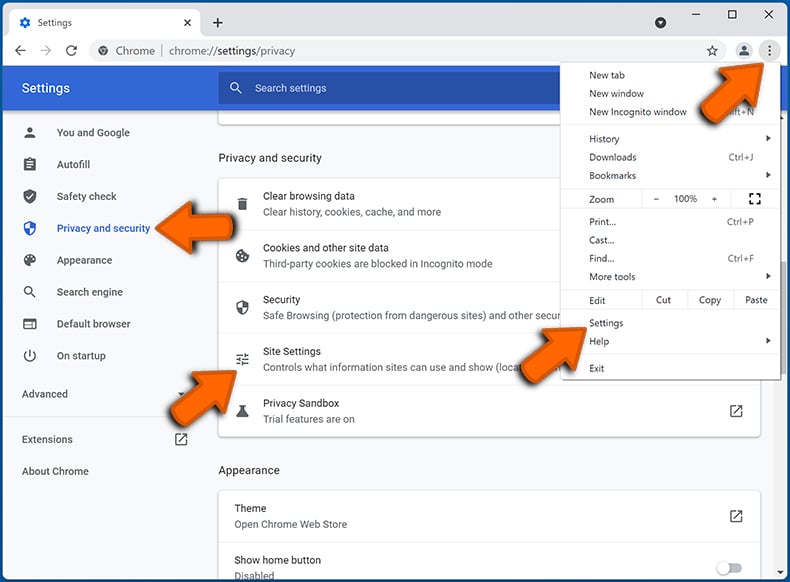
In the "Allowed to send notifications" list search for websites that you want to stop receiving notifications from. Click on the three dots icon near the website URL and click "Block" or "Remove" (if you click "Remove" and visit the malicious site once more, it will ask to enable notifications again).
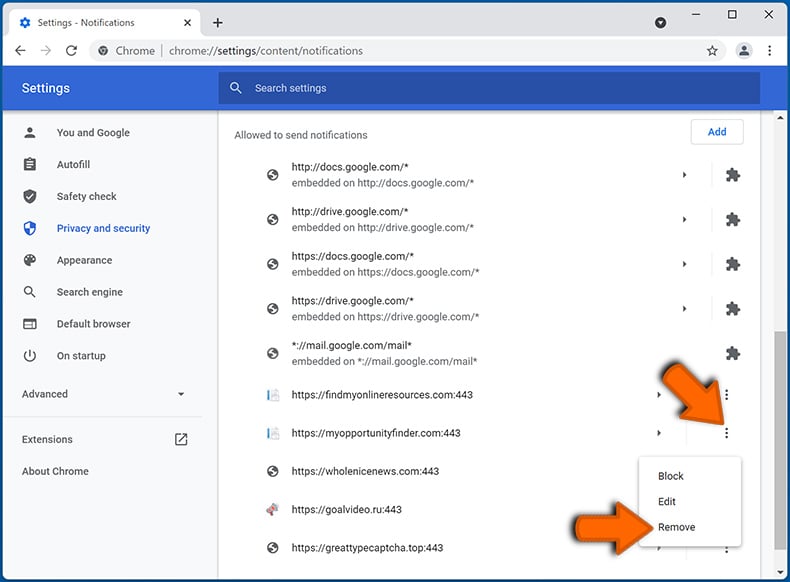
 Remove spam notifications from Google Chrome (Android):
Remove spam notifications from Google Chrome (Android):
Tap the Menu button (three dots) on the right upper corner of the screen and select "Settings". Scroll down, tap on "Site settings" and then "Notifications".
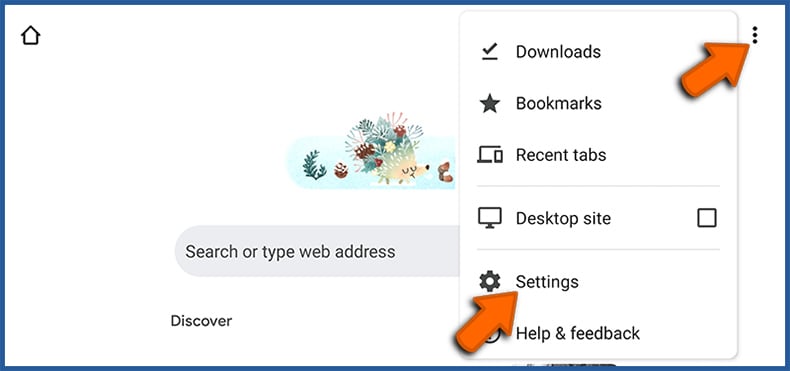
In the opened window, locate all suspicious URLs and tap on them one-by-one. Once the pop-up shows up, select either "Block" or "Remove" (if you tap "Remove" and visit the malicious site once more, it will ask to enable notifications again).
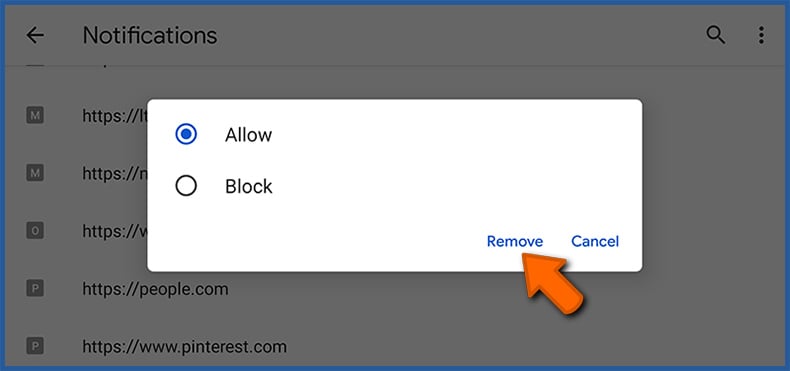
 Remove spam notifications from Mozilla Firefox:
Remove spam notifications from Mozilla Firefox:
Click the Menu button (three bars) on the right upper corner of the screen. Select "Settings" and click on "Privacy & Security" in the toolbar on the left hand side of the screen. Scroll down to the "Permissions" section and click the "Settings" button next to "Notifications".
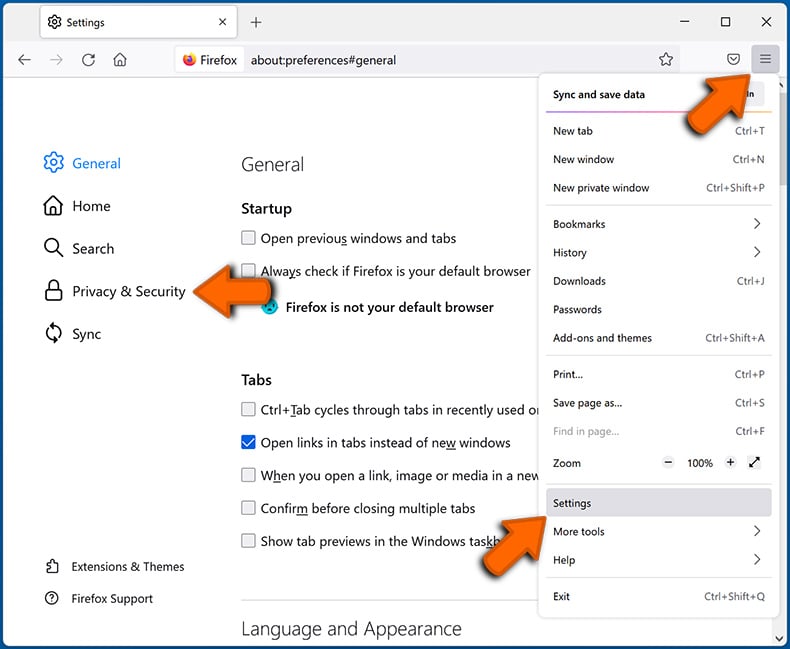
In the opened window, locate all suspicious URLs and block them using the drop-down menu or either remove them by clicking "Remove Website" at the bottom of the window (if you click "Remove Website" and visit the malicious site once more, it will ask to enable notifications again).
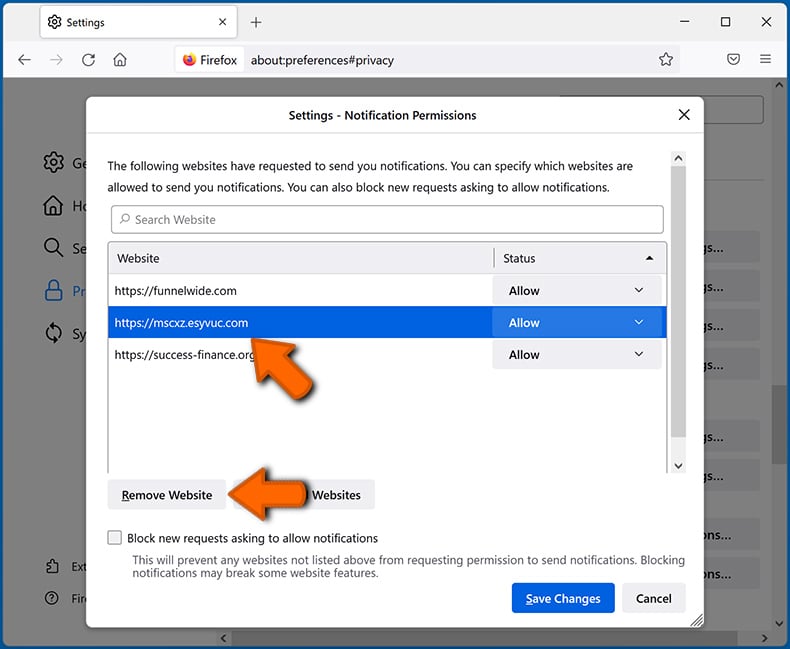
 Remove spam notifications from Microsoft Edge:
Remove spam notifications from Microsoft Edge:
Click the menu button (three dots) on the right upper corner of the Edge window and select "Settings". Click on "Cookies and site permissions" in the toolbar on the left hand side of the screen and select "Notifications".
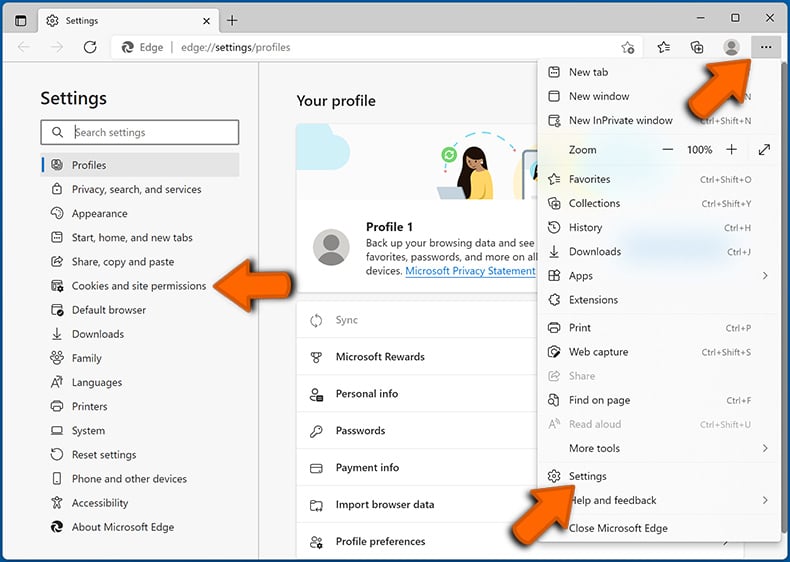
Click three dots on the right hand side of each suspicious URL under "Allow" section and click "Block" or "Remove" (if you click "Remove" and visit the malicious site once more, it will ask to enable notifications again).
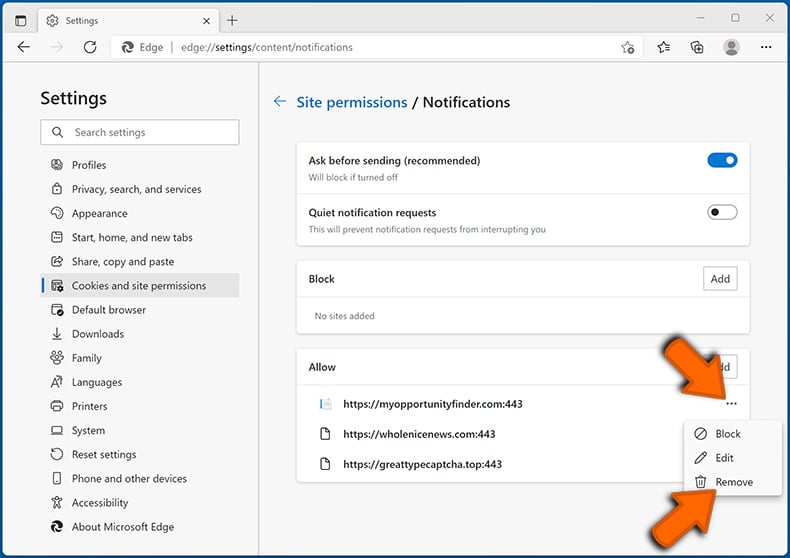
 Remove spam notifications from Safari (macOS):
Remove spam notifications from Safari (macOS):
Click "Safari" button on the left upper corner of the screen and select "Preferences...". Select the "Websites" tab and then select "Notifications" section on the left pane.
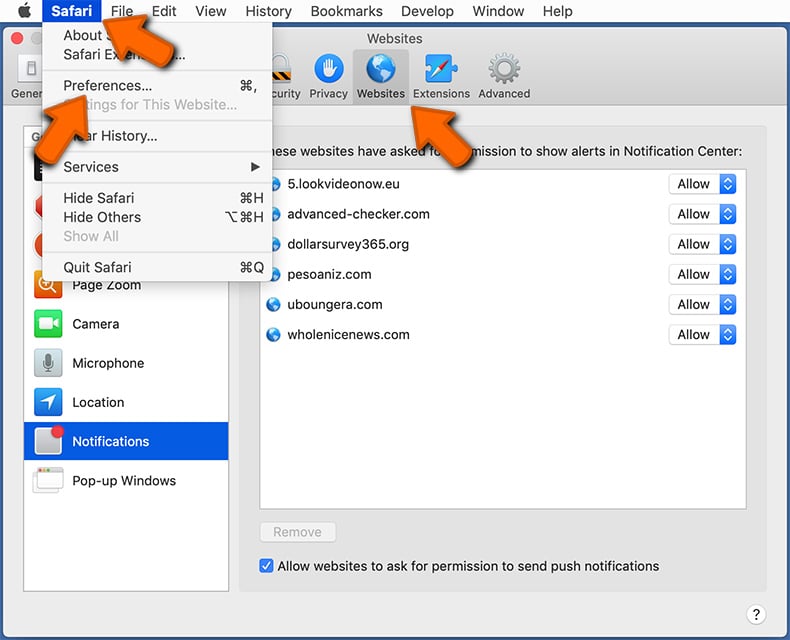
Check for suspicious URLs and apply the "Deny" option using the drop-down menu or either remove them by clicking "Remove" at the bottom of the window (if you click "Remove" and visit the malicious site once more, it will ask to enable notifications again)
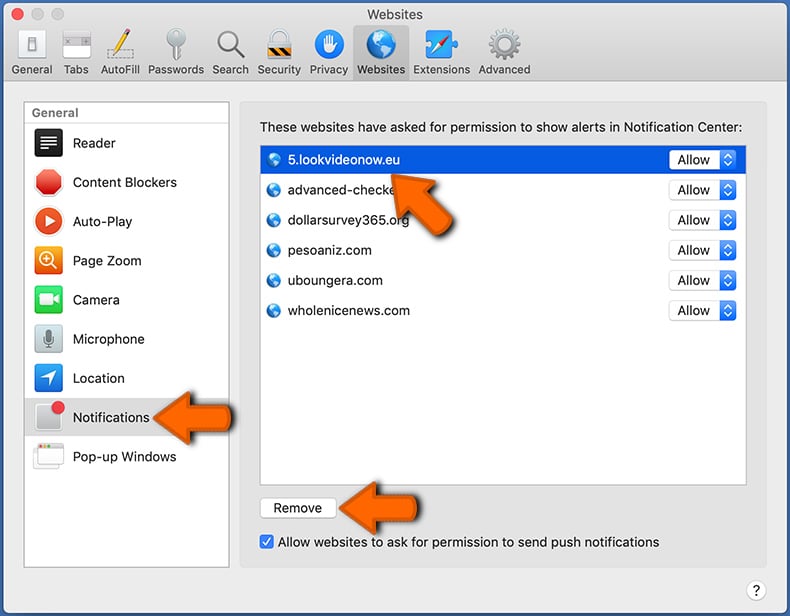
How to avoid browser notification spam?
Internet users should be very skeptical when being asked to allow notifications. While this is a useful feature that allows you to receive timely news from websites you like, deceptive marketers frequently abuse it.
Only allow notifications from websites that you fully trust. For added security - use an anti-malware application with a real-time web browsing monitor to block shady websites that tries to trick you into allowing spam notifications. We recommend using Combo Cleaner Antivirus for Windows.
Share:

Tomas Meskauskas
Expert security researcher, professional malware analyst
I am passionate about computer security and technology. I have an experience of over 10 years working in various companies related to computer technical issue solving and Internet security. I have been working as an author and editor for pcrisk.com since 2010. Follow me on Twitter and LinkedIn to stay informed about the latest online security threats.
PCrisk security portal is brought by a company RCS LT.
Joined forces of security researchers help educate computer users about the latest online security threats. More information about the company RCS LT.
Our malware removal guides are free. However, if you want to support us you can send us a donation.
DonatePCrisk security portal is brought by a company RCS LT.
Joined forces of security researchers help educate computer users about the latest online security threats. More information about the company RCS LT.
Our malware removal guides are free. However, if you want to support us you can send us a donation.
Donate
▼ Show Discussion